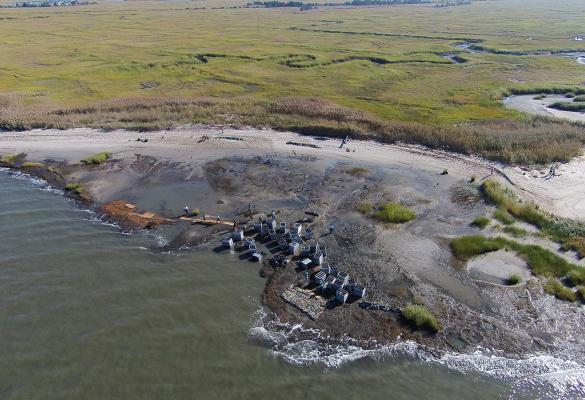Living Shoreline Creation
Living shoreline creation refers to the process of planting vegetation along the shoreline and installing structures that help hold the vegetation in place (Olander et al. 2021). Living shorelines help prevent erosion along the shoreline, providing an alternative to traditional gray infrastructure like bulkheads, ripraps, or jetties (Figure 1). These hardened shorelines are on the rise as American coastal regions rapidly urbanize, with one-third of American coastlines expected to be hardened by 2100. Living shorelines are often preferred to gray infrastructure because of their ability to trap sediments from tidal waters, allowing them to gain elevation as sea levels rise (NOAA 2023). Most living shorelines include a breakwater composed of bagged oyster shells, granite, eco-friendly concrete, or reef balls (Olander et al. 2021). Living shoreline creation typically involves planting vegetation, installing organic material, constructing oyster reefs or living breakwaters, and adding sills or other holding structures (NOAA n.d.).

Case Studies
Charlotte Harbor Estuary Program, North Fort Myers (Gulf of Mexico)
Constructed Marsh With Breakwaters: Mobile Bay, Alabama
Designing Living Shorelines for New England Coasts
Dredged Sediment in an Uncontrolled Diversion
Dune Restoration Increases Flood Protection & Access for Community
Duwamish River Estuary Intertidal Wetlands Restoration
Florida Cat Point Living Shoreline Project
Florida Pensacola Bay Living Shoreline Project
Fowl River Private Living Shorelines
From Gray to Green: Replacing a Bulkhead with a Living Shoreline at a High-Energy Riverine Site
Little Lagoon Living Shoreline
MacDill Oyster Reef Shoreline Stabilization
Marsh Enhancement With Toe Protection: Great Egg Harbor Bay, NJ
North Cape Bird Restoration, Block Island Sound
North Cape Shellfish Restoration, Block Island Sound
Point aux Pins Living Shorelines
Restoring Bolsa Chica Wetlands
Restoring Tidal Wetlands at Sonoma Baylands, San Francisco Bay
Salt Marsh Restoration on Barren Island in Chesapeake Bay
San Francisco Bay Living Shorelines Project
Staying Even with Mother Nature
Swift Tract Oyster Reef Breakwaters
Sylvan Lake Avon-by-the-Sea, NJ
Using Low Impact Development Concepts to Reduce Flooding, Norfolk, Virginia
Tools
A Guide to Living Shorelines in Texas
Coastal Adaptation Strategies Handbook
Evaluating tidal saline wetland migration along the U.S. Gulf of America
Florida Sea Grant Living Shorelines Training for Marine Contractors
Green Infrastructure Effectiveness Database
Guidance for Considering the Use of Living Shorelines
Living Shorelines Engineering Guidelines
Living Shorelines Training for Marine Contractors
Living Shorelines and Nature-Based Solutions Guidebook
Mitigation Action Portfolio (MAP)
NOAA's Living Shoreline Projects
Natural and Structural Measures for Shoreline Stabilization
Promoting Nature-Based Hazard Mitigation Through FEMA Mitigation Grants
Using Nature-Based Solutions Across Landscapes (Infographic)
Working with Nature: A Guide to Native Plants for New York’s Great Lakes Shorelines
Likely Benefits and Outcomes
This strategy is likely to achieve these project goals. Click to search for strategies with a similar benefit.
Related Green (natured-based) vs. Gray infrastructure
In development.
